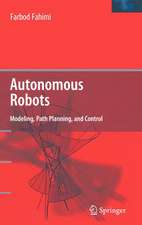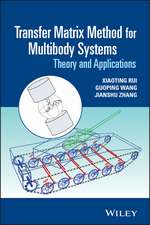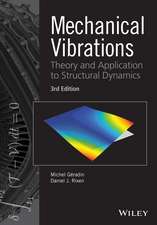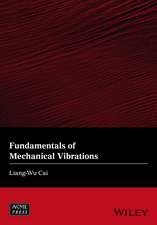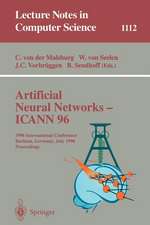On the Construction of Artificial Brains
Editat de Ulrich Ramacher, Christoph von der Malsburgen Limba Engleză Paperback – 23 aug 2016
The neuro-synaptic network owes its functional power to the introduction of rapidly modifiable dynamic synapses. These give a network greater pattern recognition capabilities than are achievable with fixed connections. The spatio-temporal correlation structure of patterns is captured by a single synaptic differential equation in a universal way. The correlation can appear as synchronous neural firing, which signals the presence of a feature in a robust way, or binds features into objects.
Although in this book we can present only a first generation artificial brain and believe many more generations will have to follow to reach the full power of the human brain, we nevertheless see a new era of computation on the horizon. There were times when computers, with their precision, reliability and blinding speed, were considered to be as superior to the wet matter of our brain as a jet plane is to a sparrow. These times seem to be over, given the fact that digital systems inspired by formal logic and controlled algorithmically - today's computers - are hitting a complexity crisis. A paradigm change is in the air: from the externally organised to the self-organised computer, of which the results described in this book may give an inkling.
| Toate formatele și edițiile | Preț | Express |
|---|---|---|
| Paperback (1) | 947.85 lei 6-8 săpt. | |
| Springer Berlin, Heidelberg – 23 aug 2016 | 947.85 lei 6-8 săpt. | |
| Hardback (1) | 955.25 lei 3-5 săpt. | |
| Springer Berlin, Heidelberg – 17 mai 2010 | 955.25 lei 3-5 săpt. |
Preț: 947.85 lei
Preț vechi: 1155.91 lei
-18% Nou
Puncte Express: 1422
Preț estimativ în valută:
181.38€ • 193.95$ • 151.22£
181.38€ • 193.95$ • 151.22£
Carte tipărită la comandă
Livrare economică 17 aprilie-01 mai
Preluare comenzi: 021 569.72.76
Specificații
ISBN-13: 9783662501979
ISBN-10: 366250197X
Pagini: 359
Ilustrații: VIII, 359 p.
Dimensiuni: 155 x 235 mm
Greutate: 0.51 kg
Ediția:2010
Editura: Springer Berlin, Heidelberg
Colecția Springer
Locul publicării:Berlin, Heidelberg, Germany
ISBN-10: 366250197X
Pagini: 359
Ilustrații: VIII, 359 p.
Dimensiuni: 155 x 235 mm
Greutate: 0.51 kg
Ediția:2010
Editura: Springer Berlin, Heidelberg
Colecția Springer
Locul publicării:Berlin, Heidelberg, Germany
Cuprins
Prologue.- The Difficulty of Modelling Artificial Brains.- Information Processing in Nets with Constant Synapses.- Theory of Nets with Constant or Dynamic Synapses.- Macro-Dynamics of Nets with Constant Synapses.- Information Processing with Dynamic Synapses.- Nets for Feature Detection.- Nets for Feature Recognition.- Nets for Robust Head Detection.- Extensions of the Vision Architecture.- Look-out.- Preliminary Considerations on the Microelectronic Implementation.- Elementary Circuits for Neurons, Synapses, and Photosensors.- Simulation of Microelectronic Neural Circuits and Systems.- Architecture and Chip Design of the Feature Recognizer.- Architecture and Chip Design of the Feature Detector.- 3D Stacking Technology.- Architecture of First Generation Vision Cube.- End.
Textul de pe ultima copertă
This book presents a first generation of artificial brains, using vision as sample application. An object recognition system is built, using neurons and synapses as exclusive building elements. The system contains a feature pyramid with 8 orientations and 5 resolution levels for 1000 objects and networks for binding of features into objects. This vision system can recognize objects robustly in the presence of changes in illumination, deformation, distance and pose (as long as object components remain visible).
The neuro-synaptic network owes its functional power to the introduction of rapidly modifiable dynamic synapses. These give a network greater pattern recognition capabilities than are achievable with fixed connections. The spatio-temporal correlation structure of patterns is captured by a single synaptic differential equation in a universal way. The correlation can appear as synchronous neural firing, which signals the presence of a feature in a robust way, or binds features into objects.
Although in this book we can present only a first generation artificial brain and believe many more generations will have to follow to reach the full power of the human brain, we nevertheless see a new era of computation on the horizon. There were times when computers, with their precision, reliability and blinding speed, were considered to be as superior to the wet matter of our brain as a jet plane is to a sparrow. These times seem to be over, given the fact that digital systems inspired by formal logic and controlled algorithmically - today's computers - are hitting a complexity crisis. A paradigm change is in the air: from the externally organised to the self-organised computer, of which the results described in this book may give an inkling.
The neuro-synaptic network owes its functional power to the introduction of rapidly modifiable dynamic synapses. These give a network greater pattern recognition capabilities than are achievable with fixed connections. The spatio-temporal correlation structure of patterns is captured by a single synaptic differential equation in a universal way. The correlation can appear as synchronous neural firing, which signals the presence of a feature in a robust way, or binds features into objects.
Although in this book we can present only a first generation artificial brain and believe many more generations will have to follow to reach the full power of the human brain, we nevertheless see a new era of computation on the horizon. There were times when computers, with their precision, reliability and blinding speed, were considered to be as superior to the wet matter of our brain as a jet plane is to a sparrow. These times seem to be over, given the fact that digital systems inspired by formal logic and controlled algorithmically - today's computers - are hitting a complexity crisis. A paradigm change is in the air: from the externally organised to the self-organised computer, of which the results described in this book may give an inkling.
Caracteristici
Presents the neurocomputer of the second generation (dynamic pulsed neural networks and its implementation on semiconductors) Well structured interdisciplinary and introductory book on artificial brains Result of a cooperation (VisionIC) between industry (Infineon) and leading research groups in brain science and complexity Uses experiment, theory and implementation in a balanced new way to construct artificial brains

